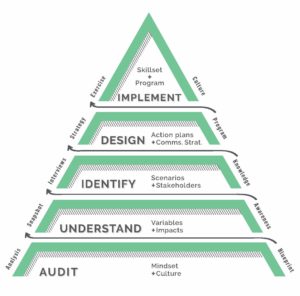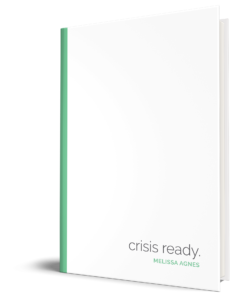Image: Melissa Agnes guest lecturing at McGill University.
 Each semester, I have the distinct pleasure of guest lecturing for colleges and universities around the world–including NYU, McGill, universities in Italy, Australia, and dozens more.
Each semester, I have the distinct pleasure of guest lecturing for colleges and universities around the world–including NYU, McGill, universities in Italy, Australia, and dozens more.
Teaching students what it means to be crisis ready, and providing them with the fundamentals of crisis readiness that they can then bring forth with them into the workforce, is one of my greatest passions. Why? Because these exceptional bright minds are the future of business, and helping them acquire a crisis ready mindset and skillset–a valued asset in business these days–gives these soon-to-be professionals a leading edge when entering into the workplace and going after their dream jobs.
For this reason, I deliberately wrote my book, Crisis Ready: Building an Invincible Brand in an Uncertain World, with students and professors in mind. As Karen Freberg, Associate Professor in Strategic Communications at the University of Louisville, puts it:
“In Crisis Ready, Melissa guides the reader through the various steps that need to be considered when looking at creating a crisis ready mindset, which I feel is essential for young professionals and students to have as they enter the workplace. Each time I was reading Crisis Ready, I was bookmarking pages and using my highlighter. This is the crisis book we all have been waiting for-it’s current, integrated within all business and communication disciplines, and provides enormous resources and applied exercises to test your crisis and risk knowledge.”
What Crisis Ready provides to students and your curriculum
 Crisis Ready was written with my Crisis Ready Model as the fundamental foundation, which outlines the 5 strategic phases of becoming crisis ready. These five phases provide a structure for course curriculums that is both easy to digest and implement. The book combines theory with real-world practice in a way that is dynamic, interesting, and applicable to modern-day professionals and businesses. It is complete with activities, challenges, quizzes, and games-all with the intent of making it an enjoyable experience for students and professionals alike.
Crisis Ready was written with my Crisis Ready Model as the fundamental foundation, which outlines the 5 strategic phases of becoming crisis ready. These five phases provide a structure for course curriculums that is both easy to digest and implement. The book combines theory with real-world practice in a way that is dynamic, interesting, and applicable to modern-day professionals and businesses. It is complete with activities, challenges, quizzes, and games-all with the intent of making it an enjoyable experience for students and professionals alike.
Following is a Facebook Live recording, where Karen Freberg interviewed me for her remarkable Social Media Professors private group. In this video, Karen and I discuss in more detail precisely how Crisis Ready applies to, and was designed to be easily adapted into different course curriculums around the world.
What types of courses does Crisis Ready apply to?
Crisis Ready is being added as required reading for the following types of courses, in colleges and universities around the world:
- Business
- Communication
- Crisis management
- Emergency management
- Marketing
- MBA programs
- Social media
- Public relations
- Risk management
It has also been included as a resource for Stukent members, as part of the platform’s expert session program.
Include Crisis Ready as part of your course’s required reading
Crisis Ready is available for your students on amazon.
If you’d like to learn more about how Crisis Ready can be incorporated into your curriculum, I’d love to discuss this with you. You can reach out and connect with me directly at melissa@melissaagnes.com.
You can also learn even more about Crisis Ready here.

Author of Crisis Ready: Building an Invincible Brand in an Uncertain World, Melissa Agnes is a leading authority on crisis preparedness, reputation management, and brand protection. Agnes is a coveted keynote speaker, commentator, and advisor to some of today’s leading organizations faced with the greatest risks. Learn more about Melissa and her work here.


Loved the read, and the way you capture everyone’s attention with a fresh and youthful vibe. But we need more then a single shot to the system, we need a sustained effort, and the only way to achieve that goal is with ‘message frequency’, the key to successful advertising. Without it, you’ll be limited like all those before you, and those too who will come after. The only way I know to sustain anyone’s attention is to ‘give them what they want, or what you tell them they need’. Take your subject matter, emergencies and disasters, it’s all about being as technologically safe as possible …. right? But the battle isn’t in the need, it’s in normality bias. This is why I’m advocating within my IP and plan the missing element, frequency via notifications, letting them know that they’ll have what they need, when they need it most, with or without a connection to the network. Did I also mention I’m working with the Exec. Dir. of the American Institute of Stress on creating an assessment to determine an individuals propensity in facing an emergency. Once one knows more about oneself, one can move forward with greater understanding … another way to say, ‘being better ready’.